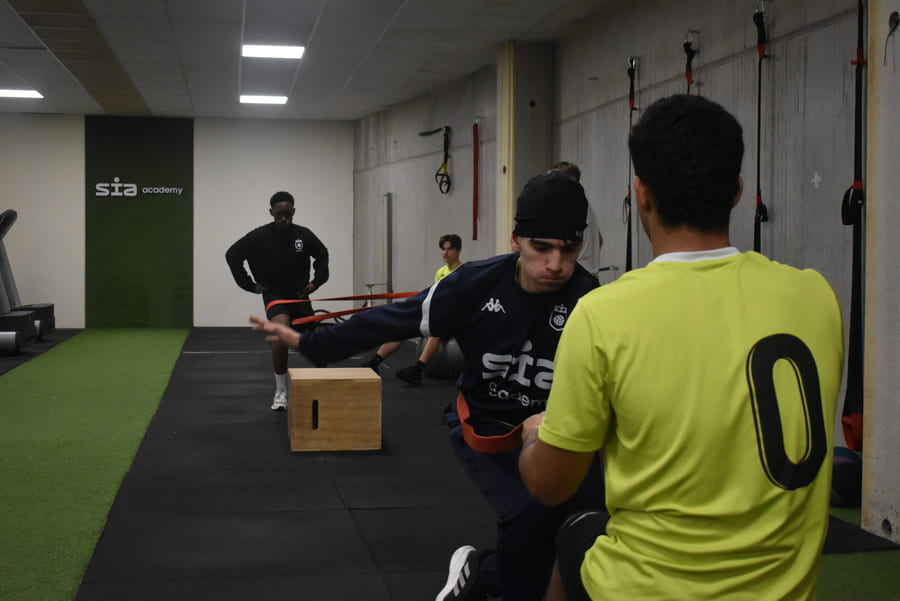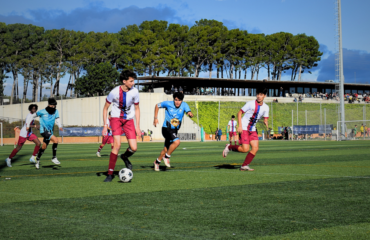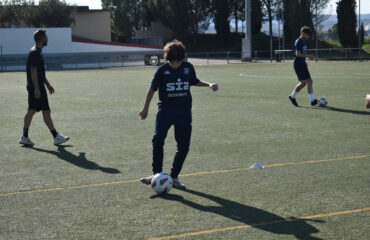The HIIT training (High-Intensity Interval Training) is a training method that combines short periods of very intense exercise with recovery phases, designed to improve cardiovascular capacity, endurance, and speed. This type of training perfectly adapts to football, a sport that demands explosive efforts, quick recovery, and sustained aerobic work. In this article, we will explore how HIIT can be applied in a football context and how SIA Academy uses it effectively to develop faster, stronger, and more efficient players.
Table of contents
What is HIIT and why does it fit football?
HIIT is based on alternating highly demanding intervals – for example, sprints, changes of direction, jumps – with active or passive rests. Its intensity causes a high metabolic demand, which stimulates the cardiovascular system, accelerates oxygen consumption, and boosts fat burning, while improving resistance to repeated efforts. For a footballer, these benefits are crucial: the game consists of intermittent explosive efforts, followed by recovery in light jogging or short pauses, during a match that may last 90 minutes or more.
Moreover, HIIT promotes physiological adaptations such as greater recovery capacity, activation of both the anaerobic and aerobic systems, and energy efficiency. That is why workouts like: 30 seconds of sprint + 60 seconds of jogging or rest, repeated several times, are very useful. But in football, these intervals must be personalized: they are often integrated with the ball, changing directions, and tactical decisions, so that the physical work is also functional and specific.
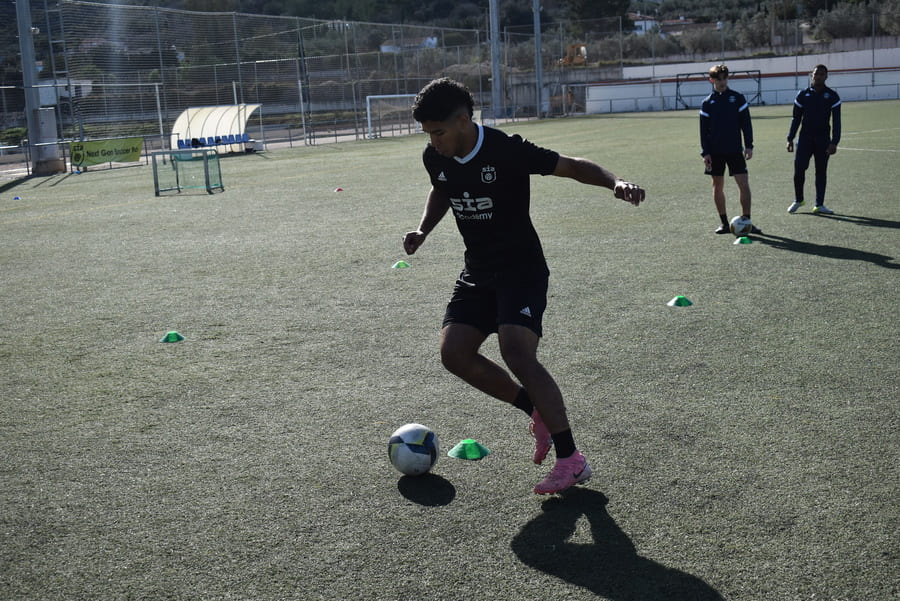
HIIT application in SIA Academy: approach and methodology
SIA Academy understands that HIIT is not just “running as hard as you can”; it is a sophisticated tool when integrated into a periodized plan. Ximo, fitness coach at SIA Academy, states that “HIIT, when properly oriented, allows players to simulate the real intensity of matches and train their recovery capacity”, which shows their performance-centered approach.
At SIA Academy, coaches design sessions that combine technical, tactical, and physical components. For example:
- Warm-up with the ball, followed by zig-zag sprints and finishing with shots on goal, all in high-demand intervals.
- Circuits mixing intense physical exercise (like agility ladders, plyometric jumps) with ball movements or defensive pressing, spaced with active jogging.
- Precise measurement of heart rate, speed, and recovery, to adjust intervals and ensure each player works in the proper zone.
“The key is to individualize the workload. Not all players have the same responses, which is why we monitor heart rate and recovery times to adapt the intervals,” comments Ximo. This attention to detail ensures that each player develops their potential without overtraining.
Specific benefits for football
- Anaerobic endurance and repeated sprint ability
The repeated use of maximum efforts followed by brief recovery strengthens the ability to maintain sprints throughout the match. - Cardiovascular efficiency and active recovery
Adaptations in the cardiovascular system allow for faster recovery after intense efforts, key for actions such as counterattacks or last-ditch defenses. - Fat loss and energy efficiency
HIIT speeds up metabolism and favors fat oxidation, keeping players in optimal body composition without losing muscle mass. - Tactical transfer
By integrating the ball and real game situations (such as pressing after losing possession), physical training merges with tactical learning and decision-making. - Motivation and variety
Sessions are dynamic, intense, and varied, which increases player motivation and improves adherence to training.
How a typical HIIT session is designed at SIA Academy
A concrete example (total duration approx. 60 minutes):
- Warm-up (15 min): mobility, ball dribbling, neuromuscular activation.
- Main block (30 min):
- Set 1: 20 m sprint + 40 m jog × 6 reps.
- Set 2: agility ladder (10 s), dribbling with changes of direction (20 s), shot on goal (10 s); active rest (1 min) × 4 rounds.
- Set 3: defensive pressing in pairs with intense lateral movement (15 s) + jogging recovery (45 s) × 5 reps.
- Cool-down (15 min): stretching, breathing work, technical feedback.
SIA Academy monitors heart rate and time under the anaerobic threshold, allowing them to adjust workloads. Again, Ximo reminds us that “without monitoring, it’s just running, but with data we can break the threshold and create real adaptations.”
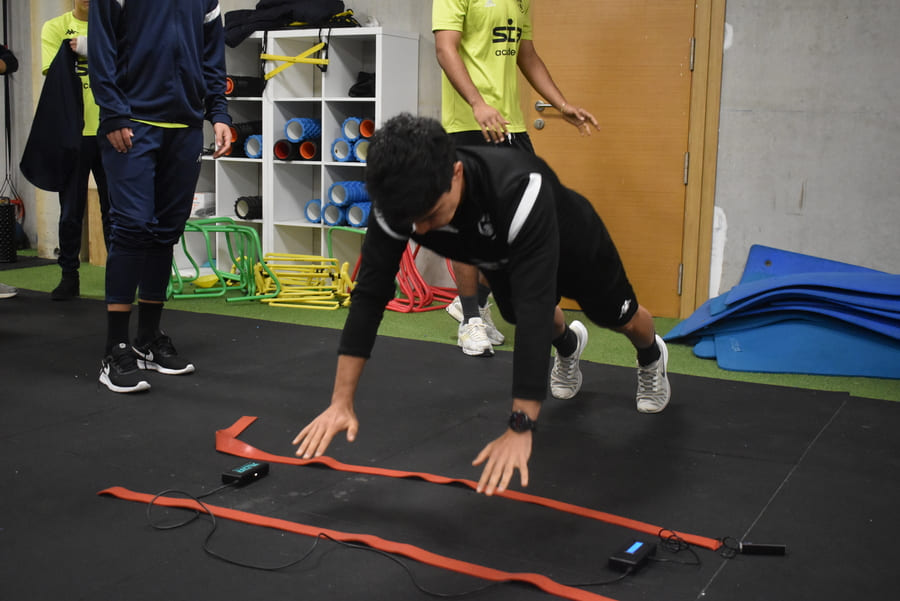
Periodization and progression
In a typical season, SIA Academy plans HIIT blocks with a specific focus:
- Pre-season: emphasis on improving general aerobic and anaerobic capacity, with gradually increasing HIIT intensity.
- First phase of competition: maintain adaptations, with one or two maintenance sessions per week.
- Congested fixtures / decisive phases: reduce volume to avoid fatigue, maintain intensity with micro-HIIT (such as isolated sprints).
- Regenerative microcycles: very light HIIT (e.g., 15 s at 90% + 45 s jogging) to activate without exhausting.
This progressive approach — pre-season, maintenance, and reduced-intensity phases — allows the body to adapt without overload, ensuring players stay fresh for key matches.
Why HIIT is essential in modern football
In summary, HIIT training, when designed with purpose, control, and progression, is a powerful tool for football. It provides key improvements in endurance, speed, recovery, and tactical efficiency. At SIA Academy, the professional approach, guided by data and adapted individually — as Ximo emphasizes — ensures that HIIT is not just a trend, but a true driver of performance for footballers. Its integration into the different phases of the season, with proper progression and tactical focus, maximizes benefits without increasing the risk of fatigue or injuries.



